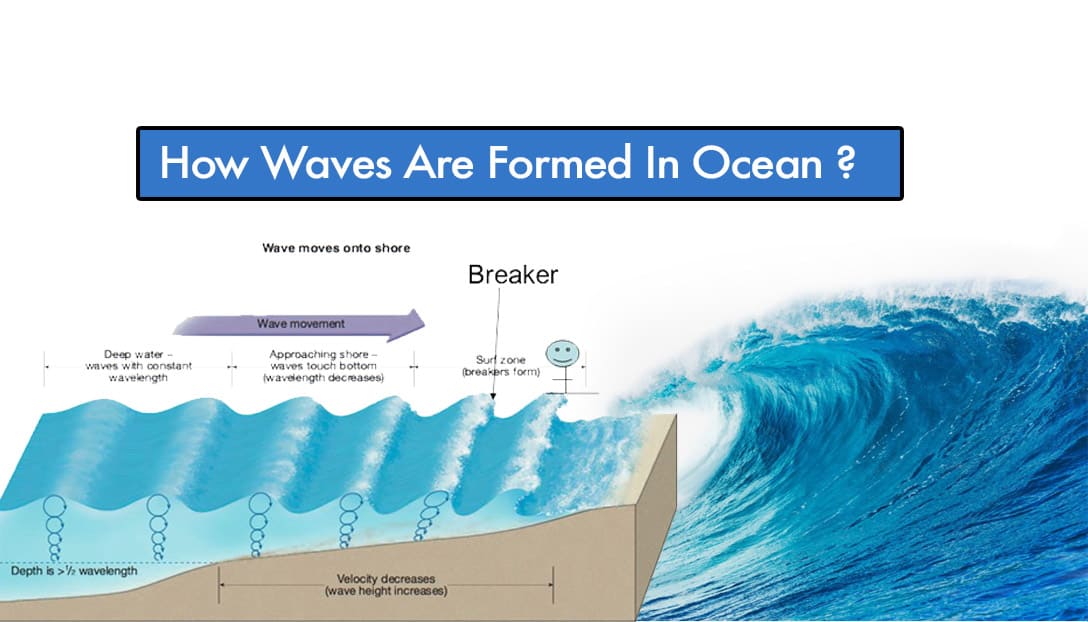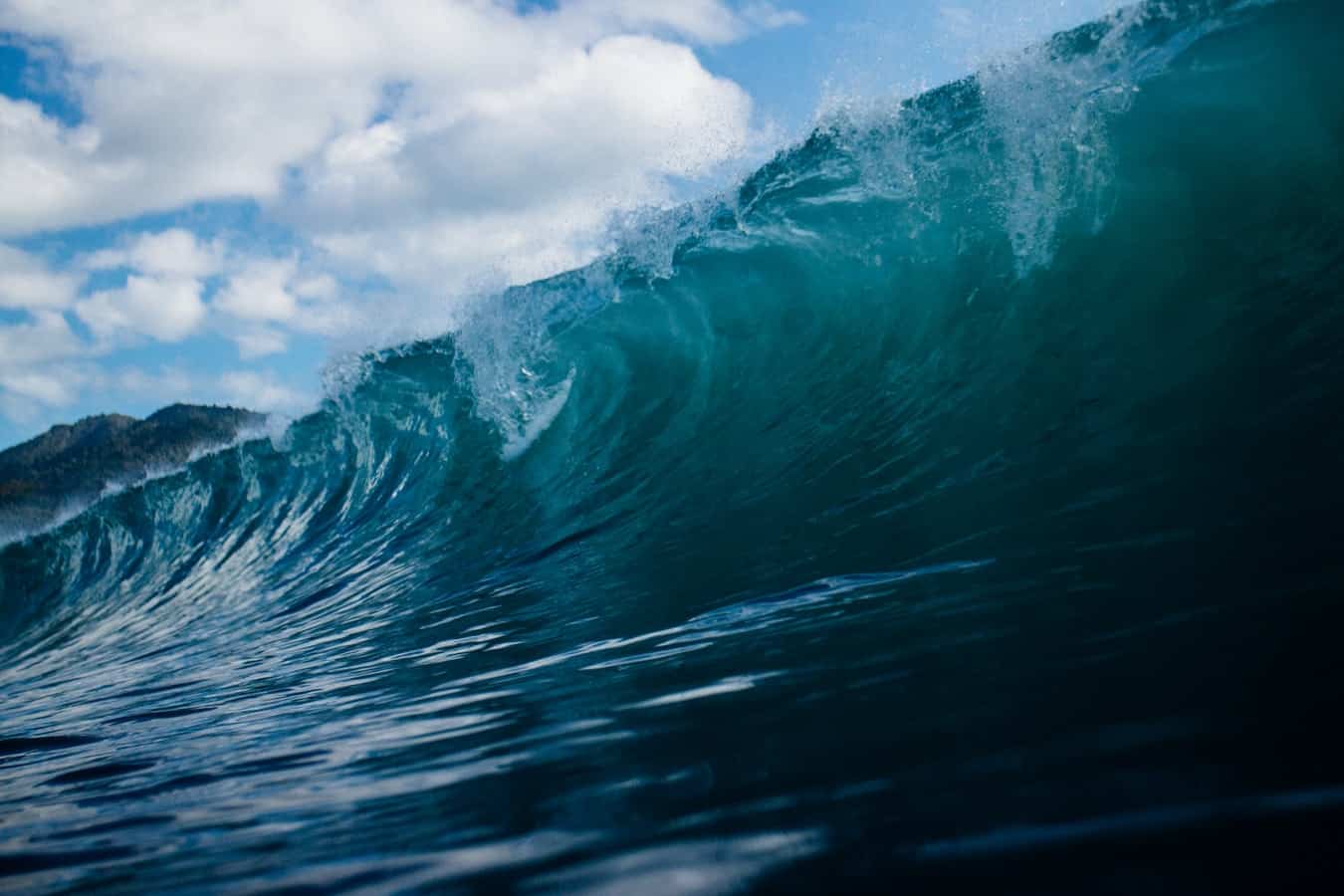Every wave is different and reading waves is an art form and skill in itself. To new surfers it can seem like a foreign language.
However, it’s a vitally important part of learning to surf. Some of the most commonly asked questions by newbies is about wave height.
How big do the waves need to be in order to go surfing? You Can surf waves as small as 1 ft. The height of surfable waves is a matter of opinion based on the surfer. Advanced surfers may find anything below 3 ft unsurfable, while a beginner can be perfectly fine in 1 ft waves.
Technically, you can surf any sized wave as long as you can stay upright and the wave has enough momentum to push you to shore.
In general though, while wave height is important in surfing, quality of the wave is just as or more important.
How Waves are Formed
All waves are not created equally. There are lots of different types of waves, all creating different surfing experiences.
To understand what waves are surfable for you, you need to know what different conditions mean. Whether the waves are a groundswell or a windswell. If the wind is offshore or onshore.
First, waves are created by energy out in the ocean, often by wind or storms off shore. The energy then ripples out, gaining momentum and eventually landing at your beach.

Swell
Groundswell and windswell indicate the type of wave you’ll have. A groundswell is a wave that comes from very far away, gaining momentum through the ground.
Windswell waves are created by the wind and are formed much closer to shore.
Due to how far they travel, groundswell waves will be cleaner as they have the time to sort out into more uniform sets.
For windswell waves, the wind is hitting the water at different wavelengths, or with different amounts of energy and speed.
These waves don’t have the thousands of miles to refine themselves, so they are choppier, smaller and in general less desirable waves.
A surf break will usually have a combination of both ground and windswell waves.
Wind Direction
Wind direction is important in figuring out what type of waves will be at your beach.
Offshore is when the wind is blowing from the shore out to the ocean. Onshore is when the wind is blowing from the ocean straight to the land.
When you have off shore winds, they basically sweep the top of the ocean out. They prop up the waves a bit, clean out the smaller, choppy waves and lead to the wave breaking with greater intensity closer to shore.
Onshore winds, obviously, blow over the water back onto the land. This speeds up the waves, causing them to crash sooner and leading them to be much choppier in general.
In an ideal situation, groundswell waves with an offshore breeze create the best waves.
Wave Breaks
Waves break as either left, right or closeout waves. Left and right closing are also known as peeling waves.
The direction is determined by the perspective of a surfer facing the shore from the water.
A peeling wave slowly breaks in either direction, giving the surfer a longer ride, while a closeout wave breaks all at once overhead. Most often, surfers are looking for peeling waves.
Wind direction contributes to how a wave breaks, but what’s underneath the water is really what dictates a wave break.
See, when a wave starts out, it’s moving as one. As it comes into shore, the bottom, or underground part of the wave is slowed down, while the upper part of the wave continues its speed.
This is what forces the wave to crest and collapse on itself. The reefs and rocks on the seafloor is what creates the types of wave breaks you’ll see at a surf spot.
How Wave Height is Measured
Oceanographers measure waves from the trough (very lowest point of the wave) to the crest or peak of a wave.
For surfers however, there actually isn’t a standardized method for measuring wave height. There’s the Hawaiian Scale, Bascom Method, The Surfable Wave Face Method, and the Body Height Scale.
These various measuring systems vary greatly in their measurement of waves.
Different people or geographic areas use different units of measurement, so make sure you’re speaking the same language when referencing wave heights with other surfers.
Hawaiian Scale
The Hawaiian scale was developed, obviously, in Hawaii. This method uses the back of the wave to measure height. Essentially about half of the actual wave face.
This can lead to problems as what most would consider an 8 ft wave would be described as about a 4 ft wave on the Hawaiian Scale.
An inability to measure waves from the shore and difficulty measuring small waves are other flaws to this system.
Bascom Method
Popular with west coast surfers, the Bascom Method measures waves from the average sea level to the crest of the wave. Standing on the shore, the wave is measured by looking out to the point of the wave and the level of the horizon.
This way of measuring waves is almost the opposite of the Hawaiian Scale. Whereas Hawaiian Scale is often an underestimation, Bascom is often seen as an overestimation.
Surfable Wave Method
The Surfable Wave Method, as the name implies, measures the height of a wave based on the area a surfer can ride. So from the bottom of the face up. It strikes a reasonable balance between the Hawaiian Scale and the Bascom Method
Body Height Scale
The Body Height Scale is another common unit of measurement. Based on where the wave crests in relation to the body while standing in the water, it’s referred to as knee high, waist high etc.
While not an exact science as every rider is a different height, it’s not a bad frame of reference.
In general body height measurements are as follows.
- Ankle High: 1 -2 feet
- Knee High: 2 – 3 feet
- Waist High: 3 – 4 feet
- Shoulder High: 4 – 5 feet
- Head High: 6 – 7 feet
- Over Head: 8 – 9 feet
- Double Over Head: 10 – 12 feet
- Triple Over Head: 16 – 18 feet
Anatomy of a Wave
Another important factor in understanding waves is understanding and being able to decipher their anatomy. The basics are the crest, trough and face.
These parts are the basics in identifying a wave, but there are other aspects important to surfers. Here’s a breakdown of wave terms and what they mean.
Crest
The crest, also called the lip, refers to the highest peak of a wave.
Trough
The trough refers to the very lowest point of the wave. When a wave is about to break, the energy through the top is stronger, pulling more water from underneath so the trough is at its lowest point.
Face or Wall
The face, also known as the wall to surfers, refers to the distance between the trough and the crest.
Shoulder
The area of the wave furthest from where the wave is breaking
Tube or Barrel
When the wave breaks and creates a barrel inside the wave. Super desirable part of the wave to surf.
Pocket or Curl
The pocket or curl is the part of a wave just before it breaks. This is usually where a surfer rides the wave and is where the power comes from to continue forward.
Whitewater
The white foam where the wave has already broken. Good for brand new surfers, these waves only push you straight forward.
Also important is to understand wavelength and wave period. The wave length is the distance between two adjacent crests or troughs. Wave period is the time between one wave crest and the next.
Catching a Wave
The whole point of learning about waves is to know how to catch them, right?
There’s several aspects to catching a wave. The first job is to read the waves and pick out the best spot.
You’re looking for where waves are breaking, but also how they’re breaking. Look for signs of underwater dangers and what directions the waves are breaking.
Once you’ve identified the best location, it’s time to paddle out.
Try to stay outside of the breaking waves as you paddle out to your spot. Not only will you stay out of the way of other surfers better, but it’ll be easier than paddling through breaking waves.
Once you’ve reached your destination there may be other surfers in line ahead of you. Wait your turn.
When it’s your turn and you’re going after the wave, position yourself so that when the wave breaks you’ll be at the shoulder.
Now paddle as hard and fast as you can. The goal in paddling is to be able to match the speed of the wave so that instead of going right under you, you are in sync with the wave and it begins to pull you.
Once you’ve “caught” the wave, it’s time to stand up. Place your hands under your chest, push yourself up and as smoothly as possible, plant your feet on your board.
Your feet should be placed with one foot forward and one foot back, hip distance apart with your knees slightly bent. This will give you the greatest stability on your board.
Now all there is to do is keep your balance and ride to shore.
Related Questions
What Size Wave is Good For Beginners?
True beginner surfers should stick with whitewater waves in the shallows until they feel confident enough to go deeper.
Whitewater waves are good to practice paddling and popping up. Once you’ve practiced, good size waves will depend on the rider and their confidence.
In general though, 2 – 3 foot waves are a reasonable size for beginners.
What is the Biggest Wave Ever Surfed?
The biggest wave ever surfed was recorded as 80 feet tall. Ridden by Rodrigo Koxa in Nazare, Portugal in 2018.

